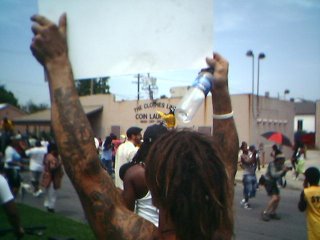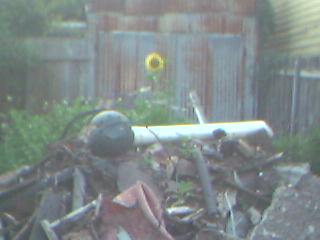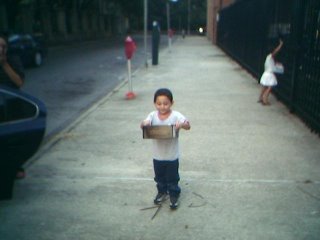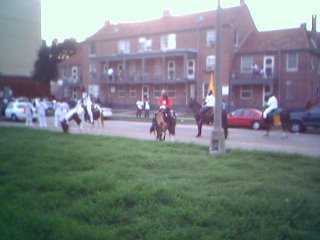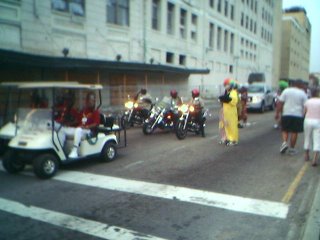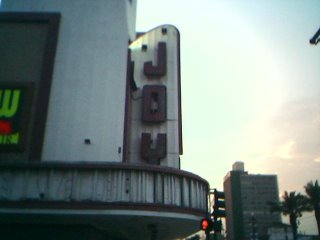Broadmoor Lives
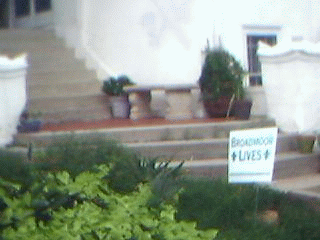 The Broadmoor neighborhood has clearly decided that one of the keys to recovery is proper signage. Every yard has at least three signs, it seems, among them "Emergency Contracting Services," "No Dumping," "Hold the Corps Accountable," "Broadmoor Lives." This last, the neighborhood slogan, appears on bumper stickers as well as yard signs and is omnipresent; a simple statement of fact, it's as well a statement of defiance of fact, or at least of odds. For Broadmoor, we must admit, is deep in the bowl. In fact, it's right around where that flowery decoration would be, the one that turned out to be the "surprise" my aunt promised I'd find if I finished my bowl of gumbo. (Few promised surprises have been more disappointing since.) It's not hard to see why urban planners called in for the Mayor's BNOB Commission would have envisioned a park replacing this neighborhood.
The Broadmoor neighborhood has clearly decided that one of the keys to recovery is proper signage. Every yard has at least three signs, it seems, among them "Emergency Contracting Services," "No Dumping," "Hold the Corps Accountable," "Broadmoor Lives." This last, the neighborhood slogan, appears on bumper stickers as well as yard signs and is omnipresent; a simple statement of fact, it's as well a statement of defiance of fact, or at least of odds. For Broadmoor, we must admit, is deep in the bowl. In fact, it's right around where that flowery decoration would be, the one that turned out to be the "surprise" my aunt promised I'd find if I finished my bowl of gumbo. (Few promised surprises have been more disappointing since.) It's not hard to see why urban planners called in for the Mayor's BNOB Commission would have envisioned a park replacing this neighborhood.But contrary to odds and what may seem reason, Broadmoor is most certainly alive. In fact, because the neighborhood was built with nuisance flooding in mind, many of the fancier places here were already raised well above the floodline, the ground floor demoted to basement service. So, these people and their signs are back. For the most part. The evidence of return is ubiquitous: flatbed trailers filled with house guts, FEMA trailers in front or side yards, lights newly strung across front porches. It's as though the word had spread from house to house, "look busy."
Taunted by my wife for proposing to take the bus, I decided to ride my bike up from the Marigny, crossing nervously (and perhaps illegally) across the Broad St. overpass and travelling up to Napoleon Ave. that way. What seemed on the map like a day's journey turned out to take less than an hour. I always forget how small this place really is.
After pedalling around a bit, I found what I thought would be the perfect pair of photos to illustrate my impressions of the place. First, the photo above, illustrating the "Broadmoor Lives" spirit in all its tenacity: the hostas freshly planted to replace the landscaping surely wrecked by the salt water, a fresh coat of paint disguising but not completely effacing the first-responders' X, and of course the requisite sign. The other was to be a photo of the house across the street: still apparently abandoned, darkened jumble of patio furniture on the enclosed front porch, yellowed grass along the sidewalks. But as I held up my phone to take the photo, I heard a voice behind me, "You gonna buy it?" I turned to see a middle-aged man, his mop-headed dog on leash beside him.
I felt guilty; suddenly I was the interloper, the disaster tourist. I made a weak attempt at a joke, "Well, it looks like someone needs to buy it." But that seemed to trouble the man even more.
"I knew the old guy who lived here. He was meticulous about this place, always keeping the grass and plants neat, always . . ." he looked away. "I'm pretty sure he would come back."
I wasn't sure what to say. It seemed so implausible to this man that his neighbor wouldn't be coming back. "Well, you know," I managed, "maybe he's just waiting on insurance money or something before he can come home."
"If that's the case, I sure do pity him."
As he and his dog walked away, I asked him where I could find the nearest bar. He told me a place, explaining, "But it's just a hole in the wall."
"Sounds perfect."
I left, forgetting to take the photo. I also managed to forget my bike lock somewhere, so I had to take a rain check on that drink. I want to go back there anyway. Something was there that I couldn't capture, couldn't make sense of without more talk and more time.
